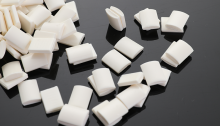During the use of hot melt adhesives, many customers will report that the glue is not sticky. However, most users encounter various troubles in the production process because they do not have a deep understanding of hot melt adhesives. The following is a detailed introduction on how to improve the bonding strength of hot melt adhesives.
1. Improve the surface roughness of hot glue
When the china hot melt infiltrates the surface of the material to be adhered well (contact angle θ<90°), the roughening of the surface is beneficial to improve the degree of infiltration of the adhesive liquid to the surface and increase the density of the contact points between the adhesive and the material to be adhered, thereby improving the bonding strength of the hot glue.

2. Hot glue surface treatment
Due to the "weak boundary layer" formed by the oxide layer (such as rust), chrome plating layer, phosphating layer, mold release agent, etc. of the adherend, the surface treatment of the adherend will affect the bonding strength of the hot glue.
In the surface treatment of aluminum and aluminum alloys, it is hoped that aluminum oxide crystals will be formed on the surface of aluminum, while the surface of naturally oxidized aluminum is very irregular, and the relati vely loose aluminum oxide layer is not conducive to bonding.
3. Prevent the penetration of hot glue
Under the action of the ambient atmosphere, the bonded joints are often infiltrated into some other low molecules, for example, when the joint is in a humid environment or underwater, water molecules penetrate into the adhesive layer;
In organic solvents, solvent molecules penetrate into the polymer subbing layer. The penetration of low molecules first deforms the wholesale hot melt adhesive layer, and then enters the interface between the adhesive layer and the adherend, reducing the strength of the adhesive layer, resulting in the destruction of the bonding.
4. Prevent hot glue from migrating
In the bonded materials containing plasticizers, these small molecules are easy to migrate from the polymer surface or interface due to their poor compatibility with polymer macromolecules. If the migrated small molecules gather on the interface, it will hinder the bonding between the wholesale hot melt adhesive and the material to be bonded, resulting in bonding failure.
5. Increase the pressure of hot glue
When bonding, pressure is applied to the bonding surface to make it easier for the adhesive to fill the pits on the surface of the adherend, and even flow into deep holes and capillaries to reduce bonding defects. For less viscous hot melt adhesives, it will flow excessively when pressurized, resulting in a lack of glue.
Therefore, the pressure should be applied when the viscosity is high, which also promotes the escape of the gas on the surface of the adherend and reduces the pores in the bonding area.
6. Thickness of hot glue layer
Thicker adhesive layers are prone to bubbles, defects and early breakage, so the adhesive layer should be made as thin as possible to obtain higher bond strength. In addition, the thermal expansion of the thick adhesive layer after being heated also causes a larger thermal stress in the interface area, which is more likely to cause joint damage.
7. Hot melt adhesive load stress
The stress acting on the actual joint is complex, including shear stress, peel stress and alternating stress.
(1) Shear stress: Due to the eccentric tension, stress concentration occurs at the end of the hot glue. In addition to the shear force, there are also tensile force consistent with the interface direction and tear force perpendicular to the interface direction. At this time, under the action of shear stress, the greater the thickness of the adherend, the greater the strength of the joint.
(2) Try to avoid the joint method that will generate peeling stress in the design.
(3) Alternating stress: The hot glue on the joint gradually fatigues due to the alternating stress, and breaks down under the condition of far lower than the static stress value. Strong and elastic adhesives (such as some rubbery adhesives) have good fatigue resistance.
8. Internal stress of hot glue
(1) Shrinkage stress: When the adhesive is cured, the volume shrinks due to volatilization, cooling and chemical reaction, causing shrinkage stress. When the shrinkage force exceeds the adhesion force, the apparent bond strength decreases significantly.
In addition, the uneven distribution of stress around the bonding end or the gap of the hot melt adhesive also produces stress concentration, increasing the possibility of cracks. When the crystalline adhesive is cured, the volume shrinks due to crystallization, which also causes the internal stress of the joint.
(2) Thermal stress: At high temperature, when the molten resin is cooled and solidified, volume shrinkage will occur, and internal stress will be generated at the interface due to the constraints of bonding.
When there is a possibility of slippage between molecular chains, the internal stress generated disappears. The main factors affecting the thermal stress of hot glue are thermal expansion coefficient, temperature difference between room temperature and Tg, and elastic difference.
We assured you that your personal information will be kept confidential. The personal data we collect is only used to process your inquiry.